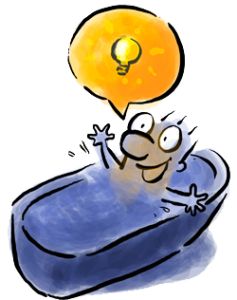I'm a big fan of Cheesymite.
It's a roll of bread consisting of cheese and Marmite, it makes for a delicious snack. And if I walk every day of the week, I reward myself with a Cheesymite on a Friday. Except it's just that some Fridays are not as good as others.
On some Fridays, the Cheesymite is fresh out of the oven
On other days, it's been sitting in the display case for about 45 minutes before I can buy it. But for every minute that it's been sitting in the case, it seems to lose its combination of crispness and yumminess. Which is about what happens to an outline when you're working on a project. That project might be an article, a webinar or a podcast—the result is similar. The longer the outline sits on your desk, the more stale it gets.
You have to think like a baker when it comes to outlining
When you sit down to outline, all you really need a tiny sheet of paper, and a pencil or pen. It's important to jot down the points right away on that sheet of paper. I tend to think in terms of three, when I'm considering my podcasts. So let's say I'm writing an outline on “why some people sell better than others”, I'll list just three sub-topics: enthusiasm, language, sequence.
And it's not like I have any clue what's going to fill those three sub-topics
But that's the next part of the outline. You first simply jot down the points you want to cover. You don't want to think about content right away. Once you're done with covering the points, you fill in the details of what you could possibly cover. In most cases, you're filling the detail with a combination of questions (how, why, when, where) and a few stories or case studies.
In the case of the first point, “transfer of enthusiasm”, here's what I'd do
I'd tell a story or two about enthusiasm. I'd demonstrate how it made a difference. The story can go both ways: it can be a story of a lack of enthusiasm and how it affected our sales, or enthusiasm and how it improved our sales.
Then I'll go into the concept of “what is enthusiasm”, “why it's important”, “when to use it and when to slow down”etc. And corny as it may seem when you're writing it down, that's really what any article, webinar or podcast is all about. It's information being drip fed with a series of questions.
Notice that we haven't started writing anything yet
And this is the paradox of outlining. You're not trying to get to the article or finished product in a hurry. Taking a little time to outline helps you think through what you're going to say, the stories you're going to use and the points you need to cover.
You also figure out the sequence in which you'll cover those points. In short, you're moving through the baking process, mixing the dough, preparing the oven—there's no Cheesymite on the horizon just yet.
But once you've got all the elements together, it's time to move quickly
The longer you sit on an outline, the greater the confusion in your head. You think of additional ideas, sometimes related to the outline itself, and sometimes to another outline. The quicker you move towards your article, the higher the chances of the article getting to the finish line.
I've had outlines that I've written (and in considerable detail too) but once the moment passes, it's very hard to generate the energy needed to write a great article. So moving quickly is the best way forward.
However, all outlines don't end up being perfect
You may create an outline, detail it and then find that you want to say something else, or may want to just drop a whole sub-topic. If that's the case, you want to go back to your sheet of paper. It's a terrible waste of time trying to fix things while writing or speaking. Going back to the original sheet of paper is the fastest, most efficient way to go. Outline the sub-topic, then the details and only then should you go back to writing or speaking.
And all outlines are not the same
Creating an outline for an 800 word article should—in time—take you no more than 5-7 minutes. When you're creating an outline for a 100 page book, however, it's a different matter. That may take all week. Nonetheless, once the outline is done, the creation work must begin or you will lose the fire and momentum.
It's a lot like my Cheesymite, when you think about it.
Some days it's perfect, some days it's just a little less than perfect.
But if I wait a few days, it's completely inedible.
What a waste!


Leave a Reply